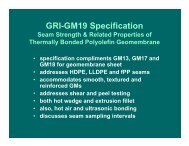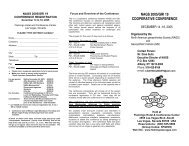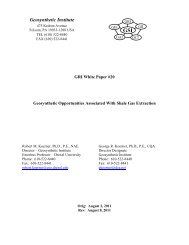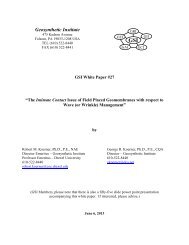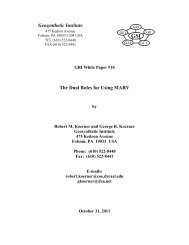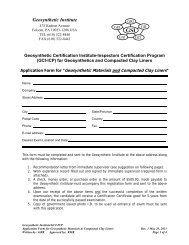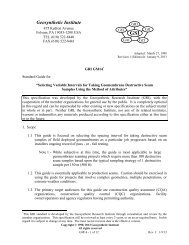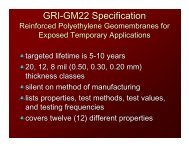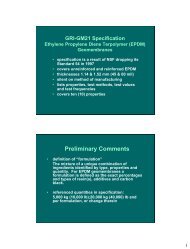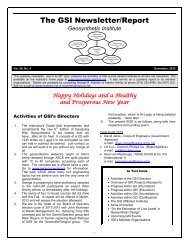GCL Design Guide - The Geosynthetic Institute
GCL Design Guide - The Geosynthetic Institute
GCL Design Guide - The Geosynthetic Institute
Create successful ePaper yourself
Turn your PDF publications into a flip-book with our unique Google optimized e-Paper software.
trichloroethane (TCE), and toluene. This was attributed to varying<br />
degrees of sorption of DCA, benzene, TCE, and toluene to the geotextile<br />
component of the <strong>GCL</strong> as well as to the bentonite present in the <strong>GCL</strong>.<br />
Diffusion coefficients (Dt) deduced from volative organic compound<br />
(VOC) diffusion testing conducted on the <strong>GCL</strong>s at confining pressures<br />
lower than approximately 10 kPa range from approximately 2 × 10 -10 m 2 /s<br />
to 3 × 10 -10 m 2 /s. Based on the results presented for inorganic<br />
contaminants, these are expected to be upper bound values for the <strong>GCL</strong><br />
with natural sodium bentonite since the bulk void ratio of a <strong>GCL</strong> installed<br />
for field conditions will be lower than that tested in the study. <strong>The</strong> effect<br />
of low temperature on diffusion of toluene through a needle-punched <strong>GCL</strong><br />
was examined by Rowe, et al. (2007). Generally speaking, the lower<br />
temperatures used during testing resulted in lower rates of organic<br />
diffusion through the <strong>GCL</strong>. This influence of temperature can be critical<br />
in harsh northern regions as discussed by Li and Li (2001). <strong>The</strong> hydraulic<br />
properties of the <strong>GCL</strong> can result in a composite subgrade/<strong>GCL</strong> soil having<br />
very little hydraulic flow through the system. Since the diffusive<br />
properties of <strong>GCL</strong>s have been well established, a contaminant transport<br />
assessment of the barrier system can be performed to assess the<br />
performance of the proposed landfill barrier system and hydrogeologic<br />
setting.<br />
11. Additional <strong>Design</strong> Considerations<br />
11.1 Freeze/Thaw Cycling—<strong>The</strong> critical property of a hydrated <strong>GCL</strong>s insofar as<br />
freeze-thaw behavior is concerned is the increase in permeability. Daniel, et al.<br />
(1997) used a rectangular laboratory flow box and subjected the entire assembly<br />
to ten freeze-thaw cycles. <strong>The</strong> permeability showed a slight increased from 1.5 ×<br />
10 -9 to 5.5 × 10 -9 cm/sec. Kraus, et al. (1997) report no change in flexible wall<br />
permeability tests of the specimens evaluated after twenty freeze-thaw cycles.<br />
Podgorney and Bennett (2006) examined the long term performance of <strong>GCL</strong>’s<br />
exposed to 150 freeze/thaw cycles and found no appreciable increase in<br />
permeability.<br />
While the moisture in the bentonite of the <strong>GCL</strong> can indeed freeze, causing<br />
disruption of the soil structure, upon thawing the bentonite is very self-healing<br />
and apparently returns to its original state. In this regard, it is fortunate that most<br />
<strong>GCL</strong>s have geotextile or geomembrane coverings so that fugitive soil particles<br />
cannot invade the bentonite structure during the expansion cycle. Thus, the<br />
bentonite does not become “contaminated” with adjacent soil particles.<br />
11.2 Dry/Wet Cycling—<strong>The</strong> behavior of dry and wet cycles insofar as a <strong>GCL</strong>’s<br />
permeability is concerned is important in many circumstances. This is<br />
particularly so when the duration and intensity of the dry cycle is sufficient to<br />
cause desiccation of the clay component of the <strong>GCL</strong>. Boardman and Daniel<br />
(1996) evaluated a single, albeit severe, dry-wet cycle on a number of <strong>GCL</strong>s and<br />
<strong>GCL</strong>5 - 20 of 34 Rev. 1: 1/9/13



